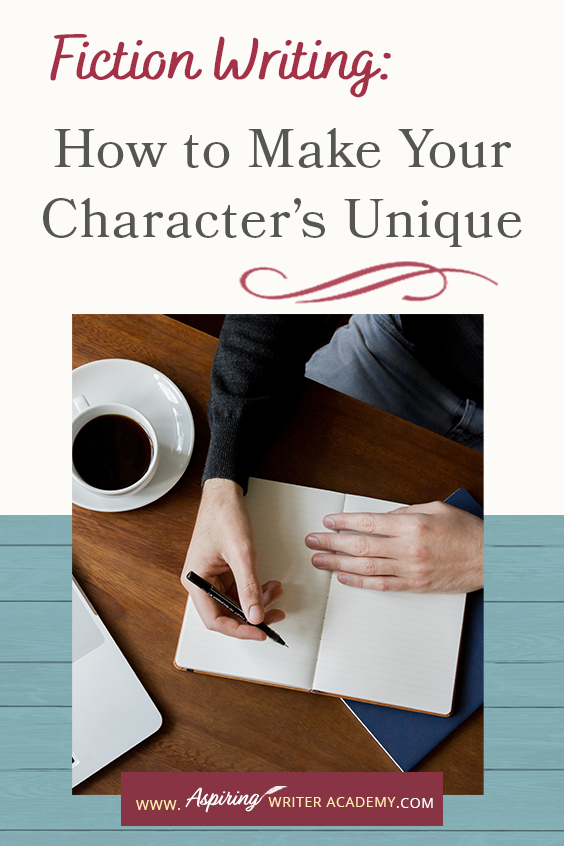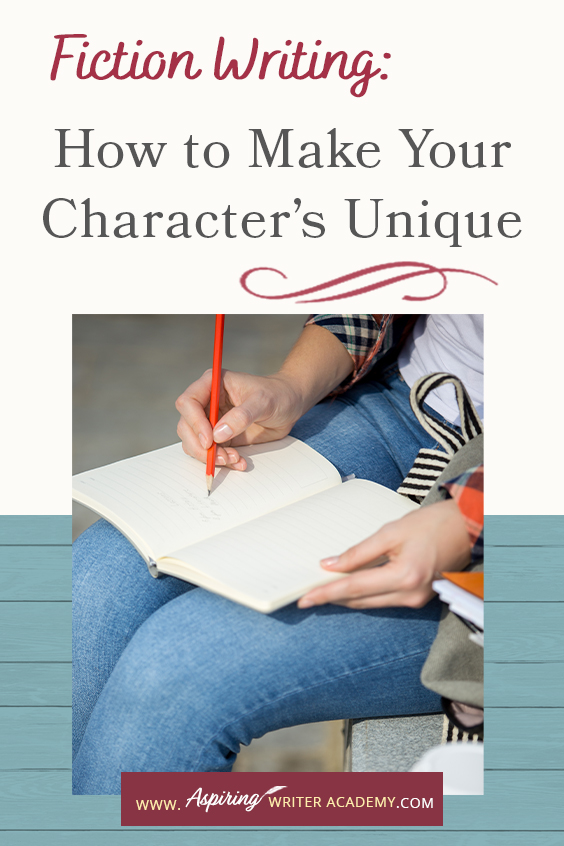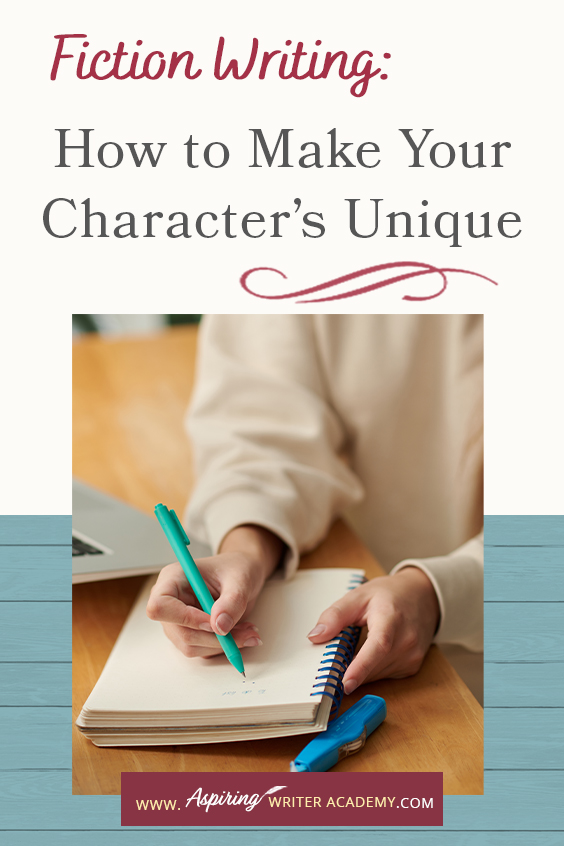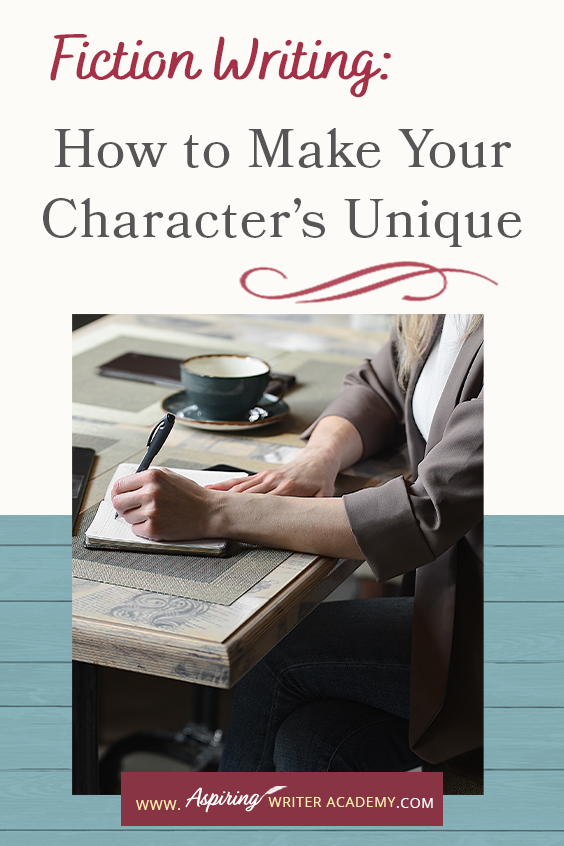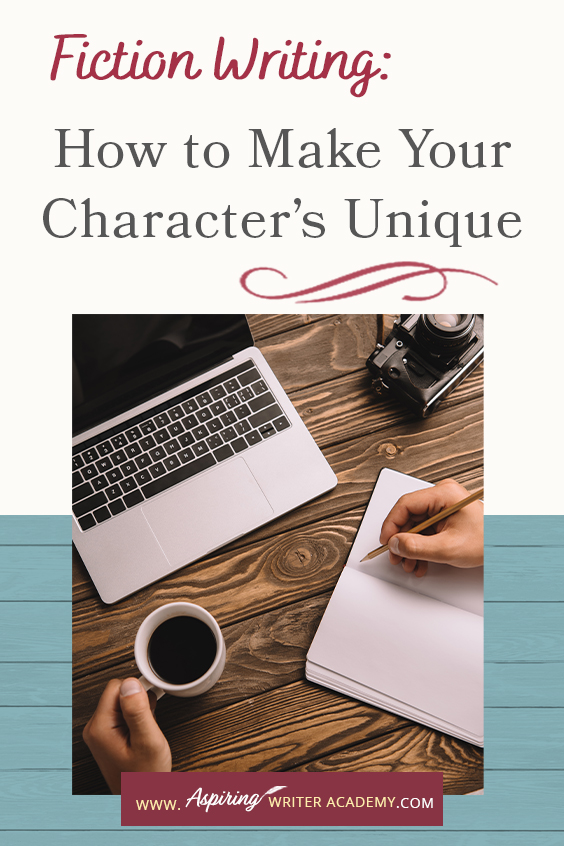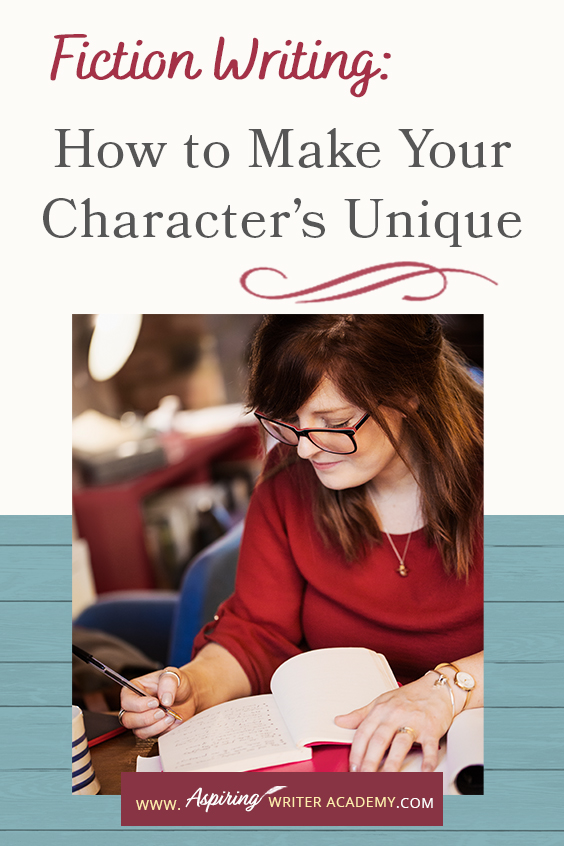Fiction Writing: How to Make Your Character’s Unique

Do you struggle to create unique characters for your fictional novel? How do you let your reader know that your main character is a worthy hero? How do you reveal your character’s personality without telling or using dialogue?
In Fiction Writing: How to Make Your Character’s Unique, we discuss the use of body language, clothing, transportation, food, drink, mannerisms, speech, physical markings, and scents & smells to help you create unique characters your readers will love.

Before you write your story, list the characters needed to play a part in your intended storyline.
- Start with your main character (who will pursue a specific goal.)
- Who opposes that character? That’s your antagonist or villain.
- Is there a love interest?
- Are there family members?
- Who is your main character’s confidant or best friend?
- Who else does your main character interact with in town or at work or while pursuing the storyline goal?
- Does your antagonist or villain have minions, others to help him?
Some of your story cast will be main characters and others will play a minor role as sub-characters. Make sure each one is necessary to tell the story.
Now…If your fictional characters could not speak, how would you convey their personality points to the reader? How would you communicate how they feel? Or reveal how they are different from the other characters in the story?

1) Body Language
Pets communicate with their owners and make their needs known. The eyes can be so expressive. Other body language can also reveal what a pet wants without any dialogue whatsoever. If a dog brings you his leash and then goes and waits by the door, tail wagging, it’s a sure sign the dog wants to go out.
I once had a golden retriever whose big brown pleading eyes would dart back and forth toward me and the ball on the ground. His long tongue hanging out of the side of his mouth only added to his obvious longing for me to throw the ball. His legs stood rigid, poised, ready to spring at a moment’s notice. His wagging tail showed how happy he would be to play ball with me. If this wasn’t enough, sometimes, he’d let out a single bark and continue to give me an anxious look. Sometimes he’d go get the ball and drop it closer to my feet. There is no doubt what my canine companion wanted.
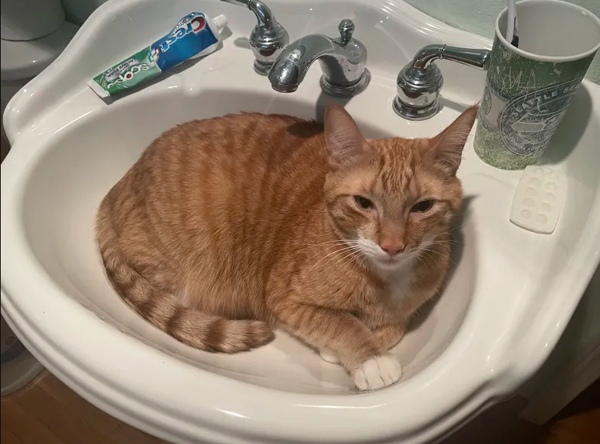
Similarly, my expressive cat subtly narrows his gaze into a half-squint when I walk in the door if he thinks I’ve been away for too long. His tiny half-squinted expression lets me know he is not happy with me at the moment. If he is really mad, he may turn his head and refuse to look me in the eye until enough time passes and I can make amends.
Give your fictional characters both small and larger actions to show who they are, what they want, and how they feel about the situations they are in, other people, and the quest to pursue their goal.
What actions can reveal your character’s personality?
In the hit TV series, Seinfeld, Kramer was known for always bursting through the door in a comical and obnoxious way.
Does your character hold her head high in the face of opposition or is she unable to meet her opponent’s gaze?
Does your character fidget when nervous?
Touch everything in the room when speaking to someone?
Rock back on their toes repeatedly and whistle when bored or waiting for someone?
How can one character’s actions/reactions in a scene be the opposite of another character and cause conflict between them?
To avoid creating a bland cast where every character seems basically the same, brainstorm different character personality traits, habits, and actions that are unique to each character. If you need help, Google ‘character traits’ online.
Also make sure that you choose actions, traits, and habits that will be important or useful to the story. Don’t assign a character a specific quirk “just because.” Know why your character has these habits or why he does these actions. What happened in this character’s past (backstory) that helped him develop these personality traits? How will this affect the present story?
Let the character’s actions reveal who they are, what they want, and how they feel!

2) Clothing
What your character wears can say volumes about his or her personality. Instead of having every character in your story wear a regular shirt and pants, dress them up to showcase their likes and dislikes. Contrast your fictional character’s clothing with others to show each of their different personalities.
If everyone works on a ranch, you can have one girl wear expensive sparkly pink chaps and a matching pink cowboy hat, while another girl may wear a blue plaid flannel shirt, a pair of faded jeans, and old muddy boots. Another character may wear a brown overcoat, another may only dress in black.
Your character’s choice of clothing may showcase how wealthy they are. Does one of your characters wear expensive suits or a ragged shirt full of holes? Does their clothing come from upscale designers or a thrift store?
Look to add telling details. Your character may wear a fancy dress to an event, but does it fit? Or are there safety pins in the back holding it together because it’s too tight and the upper clasp broke off? Or is there a small tear in the hem? Is this character trying to present a public image that is inconsistent with who she really is?
Also consider—what kind of accessories does each character wear with their attire? Pearls, jewels, a gold pocket watch, a baseball cap, scarf, purse, or a rodeo belt buckle?
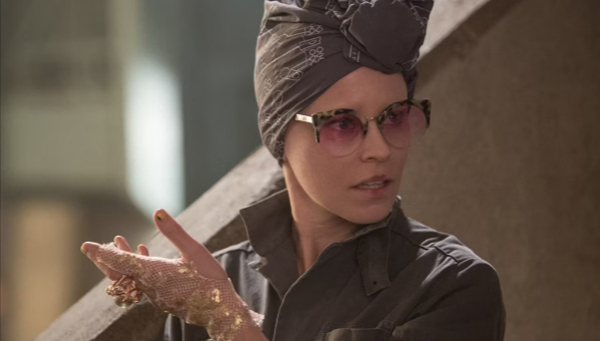
In the film series, The Hunger Games, based on the novels by Suzanne Collins, the audience is introduced to the quirky character, Effie Trinket, who flaunts colorful, unique hair styles and attire. Even her name ‘Trinket’ suggests she likes accessories.
Even in the last part of the series, The Hunger Games: Mockingjay – Part 1 (2014), when Effie is taken to District 13 and is stripped of all her usual fineries, she uses what she can to keep her signature style. She may be in a gray colorless jumpsuit, but she takes a strip of cloth and wraps her hair in a matching gray turban that sits high atop her head. She will use whatever she can to make herself appear fashionable in any circumstance!

3) Transportation
What kind of car or truck does your fictional character drive? Or do they drive at all? Do they take the bus or a taxi or Uber to work each day? Do they ride a horse or mostly drive a golf cart? Or perhaps ride on a motorcycle or tractor?
Your characters actions, clothing, and transportation should all match their personality and if it is inconsistent with who they are—there must be a reason why.

Example:
You could have a character ‘stuck’ driving a Volkswagen bug, even if he cannot stand driving such a vehicle, because his own car broke down or he cannot afford anything else.
This will cause conflict for this character if he needs to transport large items that do not fit inside the small car’s interior or if he has long legs that are scrunched while sitting in the front seat. Other characters may even tease him for driving this vehicle, knowing it is not right for him. How will he handle their criticism? Will he sneer or give these other characters a rueful grin?
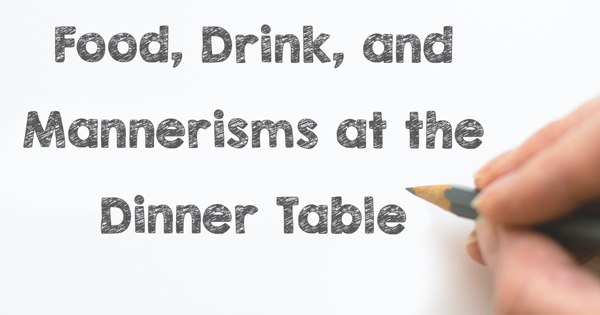
4) Food, Drink, and Mannerisms at the Dinner Table
What is your character’s favorite food? Every character may have a different preference. Does it matter to the story or scene at hand? Does it cause conflict? Will this character eat food they do not like to be social or if forced?
What does your character drink? Soda, flavored water, tea, specialty coffee, margaritas, whisky? Will a character refuse to drink alcohol? Why? Make sure that your characters have a reason for their preferences.
Does one character only eat vegan or gluten free? Does anyone have dietary restrictions?
If your whole cast of characters were together at a dinner table, how would their mannerisms differ?
Does one character eat only with their spoon? Or hold their fork and knife differently than others to cut their meat?
Does a character chew with his mouth open? Or spit food when laughing?
Does your character sit straight and tall or slouch over their meal?
Is one clumsy who knocks over their water or wine glass?
Does a character respectfully say grace (thankful for their food?) Or dive into their meal, spooning out heaping portions, without a care about saving enough for everyone else?
Is there a character who sprinkles a ton of salt over all their food?
Or another who habitually kicks others under the dinner table?
How do the food they eat, the drinks they consume, and their table manners reveal each character’s unique personality?

5) Speech
How do your characters speak to one another? How can their speech reveal their personality and perhaps some of their background?
Does your character have a southern accent? A British or Scottish or Norwegian accent?
Does your character use a lot of modern slang or is it formal and dated to reveal this is a historical novel?
Consider your character’s age. Does he or she talk like a two-year-old, a middle schooler, a love-struck teenager, an older adult?
Also consider your character’s profession. Does your character speak with military lingo, or more like a college professor, a gardener, or a doctor or lawyer with words and special phrases that the reader can easily identify with those professions?
Does your fictional character have any speech impediments or quirks in the way they phrase their words that are unique?

6) Physical Markings to Reveal Character
In the classic 1975 movie “Jaws” there is a scene where the three men on the boat show off their scars to one another. The boat captain had a scar from a shark bite revealing he was tough and experienced with sharks.
Do any of your characters have tattoos or body piercings? Does this align with their personality and show the reader what kind of character they are?
Is there a character who may have had cosmetic surgery? Was it done for vanity or necessity after a car accident?
Do any of your fictional characters have a limp or disability? Does anyone use a cane, a walker, a wheelchair, a scooter they lean on with one knee after foot surgery? Is anyone on crutches?

7) Scents and Smells
How does your character smell? How does one character in your story smell differently than another?
Does one character often reek of alcohol? Or talcum powder? Or a specific brand of perfume? Does one character smell like his favorite brand of cigars? Or cigarette smoke? Does another character smell like roses or horses, hay, and saddle leather?
A baby will smell different than an 80-year-old man.
Is anyone allergic to specific scents and smells? At many conferences, attendees are instructed not to wear any deodorant or body products containing perfumes and scents, because others in attendance may have an allergy to the smell.
Do other characters find the scent of a character attractive?
Other characters may find the smell of another offensive, and this can cause conflict. One character may not want to stand next to another in a subway because their body odor is foul.
Does your character work on car engines? Does he smell like gas, oil, or grease?
Or does he work in a hospital where his clothes reek of antiseptic?
Does your character cook? Do his clothes smell like garlic and onions?
What can smell reveal about each of your fictional characters?
We hope you have enjoyed Fiction Writing: How to Make Your Character’s Unique and that you have gained some valuable tips to create an individualized cast that readers will love.
If you have any questions or would like to leave a comment below, we would love to hear from you!
If you like more help developing your story, you may wish to download our Free Brainstorming Your Story Idea Worksheet
Do you find it difficult to create compelling antagonists and villains for your stories? Do your villains feel cartoonish and unbelievable? Do they lack motivation or a specific game plan? Discover the secrets to crafting villains that will stick with your readers long after they finish your story, with our How to Create Antagonists & Villains Workbook.
This 32-page instructional workbook is packed with valuable fill-in-the-blank templates and practical advice to help you create memorable and effective antagonists and villains. Whether you're a seasoned writer or just starting out, this workbook will take your writing to the next level.
We Believe All Authors Can Aspire to Take Their Writing to the Next Level!
Our Goal for Aspiring Writer Academy is to help people learn how to write quality fiction, teach them to publish and promote their work, and to give them the necessary tools to pursue a writing career.

ENTER YOUR EMAIL BELOW
TO GET YOUR FREE
"Brainstorming Your Story Idea Worksheet"
7 easy fill-in-the-blank pages,
+ 2 bonus pages filled with additional story examples.
A valuable tool to develop story plots again and again.
Other Blog Posts You May Like
How to Use Framing Techniques in Your Fictional Novel
Fiction Writing: Create Character Profiles (with Free Questionnaire)
How to Create a Fictional Character in 5 Steps
Fiction Writing: What is the ‘Man in the Mirror Moment?’
How to Create a Diverse Cast of Characters for Your Fictional Novel
Write Your First Novel: How Do You Start?
Fiction Writing: What is a Character Arc?
How to Create Antagonists Who Are Not Villains
How to Create the Protagonist for Your Fictional Story
How to Choose Characters to Populate Your Fictional Story
Fiction Writing: How to Plot a Story where the Antagonist is an ‘Invisible Foe’
Creative Writing: 5 Ways to Strengthen a Weak Fictional Character
Fiction Writing: How to Write Compelling Dialogue
5 Questions to Create Believable Villains
Why Your Characters Need Story-Worthy Goals

is a multi-published author, speaker, and writing coach. She writes sweet contemporary, inspirational, and historical romance and loves teaching aspiring writers how to write quality fiction. Read her inspiring story of how she published her first book and launched a successful writing career.

